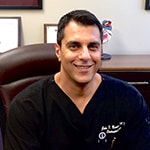What is Cardiac Resynchronization Therapy?
Cardiac resynchronization therapy (CRT) involves a procedure to insert a pacemaker or implantable cardioverter defibrillator (ICD) into the chest in order to maintain the heart’s rhythm. This ensures that the heart’s chambers are contracting efficiently to pump blood to other areas of the body. Cardiac resynchronization therapy can help to manage a variety of heart arrhythmia conditions, preventing complications such as heart failure.
Why is Cardiac Resynchronization Therapy done?
Cardiac resynchronization therapy is used to deliver a shock to the heart, restoring the normal electrical system to keep the heart beating regularly. When heart conditions prevent the ventricles from contracting at the same time, the heart muscle is unable to efficiently pump blood to the rest of the body, resulting in heart failure. Those at risk of heart failure can receive cardiac resynchronization therapy with a pacemaker or ICD in order to reduce symptoms and prevent heart failure complications, including sudden death.
When is Cardiac Resynchronization Therapy Needed?
Cardiac resynchronization therapy may be suggested after an ECG and other testing indicates an irregular heartbeat. Heart failure occurs in various stages, so an ECG may be required to diagnose heart failure if symptoms have not occurred. Symptoms of progressed heart failure that may require CRT include:
- Irregular heartbeat
- Congested lungs and a cough
- Wheezing when breathing
- Shortness of breath
- Rapid breathing
- Chest pain
- Skin appearing blue
- Fainting (syncope)
Dr. Beshai might suggest cardiac resynchronization therapy to manage these symptoms and prevent them from causing more serious complications.
Have Inquiries About Our Services?
How is Cardiac Resynchronization Therapy Performed?
Cardiac resynchronization therapy will be performed with sedation to ensure you are relaxed and comfortable. During the procedure, lead wires called electrodes will be inserted through a vein, typically in the collarbones, and guided to the heart. One end of the electrode will be attached to the heart, while the other is attached to a pulse generator. This will be implanted under the skin near the collarbone. The device that is used to regulate the heart will depend on your symptoms and how at-risk you are for sudden cardiac death. A pacemaker may be used to ensure that each area of the heart remains in sync, while an ICD may be used to detect dangerous heart rhythms, shocking the heart in order to prevent failure or sudden cardiac death.
What are the Next Steps After Cardiac Resynchronization Therapy?
After cardiac resynchronization therapy, you will be moved to a recovery room to be monitored. You might feel some soreness in the chest where the device was inserted, but most people can return to their regular activities in just a few days. You will have a follow-up treatment with Dr. Beshai to ensure that the device is working properly. Both the pacemaker and ICD are life-long devices, with no need for replacement or removal. You will want to take extra precautions when it comes to metal detectors and wands. Always let someone know that you have the device first.
Scheduling Your Cardiac Resynchronization Therapy Appointment
Dr. Beshai offers cardiac resynchronization therapy to manage the symptoms of dangerous arrhythmias and prevent heart failure complications. If you think you could benefit from CRT or want to learn more, contact our office and schedule your appointment at the Heart Rhythm Institute of Arizona.
Does cardiac resynchronization work?
Studies have shown that cardiac resynchronization therapy (CRT) can improve symptoms, quality of life, exercise tolerance, and overall survival in patients with heart failure and electrical delay called left bundle branch block. However, not all patients with heart failure will benefit from CRT, and careful patient selection is important to ensure the best outcomes.
Does CRT cure heart failure?
CRT does not cure heart failure, but it will offer relief from symptoms like shortness of breath, fatigue, exercise intolerance and may result in improvement in overall heart function.
Does CRT improve ejection fraction?
In clinical trials, CRT has not only demonstrated improvement in heart failure symptoms but also in improvement of left ventricular ejection fraction (LVEF). LVEF is your overall heart pumping function.
How long does a CRT procedure take?
Typically the procedure only takes about 90 minutes.
What is CRT short for?
CRT stands for cardiac resynchronization therapy.
What is CRT used for?
CRT is an indicated implanted device therapy for patients with moderate heart failure symptoms, low ejection fraction, and electrical delay measured on an ECG.
What is the difference between CRT and pacemaker?
A pacemaker typically will pace in the right upper and lower chambers of the heart. In some heart failure patients, there is an electrical delay between the right and left bottom chambers (ventricles) of the heart. The results in an unsynchronized beating of the 2 bottom chambers. Think of it as if your hearts alignment is off and it now requires re-alignment so that the chambers can be synchronized.
Where is the CRT lead placed in the heart?
Typically there are 3 leads placed. Leads are placed to the right upper chamber (atrium), the right lower chamber (ventricle) and the left lower chamber (ventricle). The left ventricular lead is placed through a vein called the coronary sinus. This vein is accessed from the right atrium and goes around to the left side of the heart.
The Heart Institute of Arizona has a wide array of services that come with our premium care. From in-office dianostics and treatable conditions, to hospital based procedures, we’ve got your heart covered.
Dr. Beshai is a board-certified electrophysiologist internationally renowned and respected for his expertise and research. Having published in major medical journals and travelled all over the world to present research, he is dedicated to providing innovative, state-of-the-art care to his patients.

